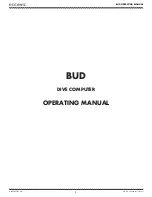
www.vtiinstruments.com
EX1629 Basic Operation
51
Maximizing Measurement Performance
in Section 1, because of the relatively
high levels of power dissipation involved, it is best to allow the bridge system elements to
thermally stabilize after an excitation source change. Excitation and unstrained voltage
measurements taken after an appropriate delay will demonstrate improved stability during the
subsequent strain testing.
NOTE
For maximum measurement performance, an excitation source change should be followed by a
thermal stabilization delay before the excitation and unstrained voltage measurements are
performed.
The default programmed values for the excitation sources are 0 V. The default enable states for the
excitation sources are off.
E
XCITATION
S
OURCE
M
EASUREMENT
For highest measurement accuracy, the EX1629 provides the ability to measure its excitation
source and use the measurement in the EU conversion. By doing so, the set point accuracy of the
excitation source ceases to be an error source. The strain accuracy tables are based on the
requirement that excitation measurement is performed.
An excitation source measurement is composed of two confidence system measurements: a
measurement of the +excitation voltage followed by a measurement of the –excitation voltage.
The total excitation voltage is then calculated as (+V
exc
) – (-V
exc
). Through program control, the
user dictates whether the measurement is used in the EU strain conversions, taking the place of the
nominal excitation value. However, because the measurement system accuracy exceeds the set
point accuracy of the source, overall strain accuracy is always improved by using the source
measurement in the EU conversion.
The excitation source measurement also provides control over whether the local sense or remote
sense lines of the excitation source are measured. If the remote sense lines are not connected to the
external strain bridge, such as in quarter-bridge configuration, either setting can be used. The
values in either case are the same. However, if the remote sense lines are connected to the bridge,
as they ideally should be in half- or full-bridge configuration, the remote sense lines should be
measured, as they represent the true source output seen by the bridge.
While a tightly regulated supply, the excitation source does, nonetheless, have a temperature drift
characteristic. For this reason, it is best to conduct the excitation source measurement just prior to
the initiation of strain measurements, making the source measurement as fresh as possible.
Moreover, to achieve maximum performance, it is best to allow the system elements to thermally
stabilize following an excitation source change before conducting its measurement. For more
details, see
Maximizing Measurement Performance
in Section 1.
NOTE
For maximum measurement performance, an excitation source change should be followed by a
thermal stabilization delay before the excitation source measurement is performed.
While measuring the excitation source is the conventional method of providing a non-nominal
value of the excitation voltage to the EU conversion, it is also possible to manually enter a value.
This would normally only be done for system diagnostic purposes.
U
NSTRAINED
V
OLTAGE
M
EASUREMENT
Integral to strain measurement, the unstrained voltage measurement mathematically removes the
effects of initial bridge imbalance by measuring the bridge voltage with the gage(s) in an
unstrained state and using the resultant value in the EU conversion. For while an unstrained bridge
would ideally have an output of 0 V, component tolerances of the gages and, if employed, the
completion resistor produce a nonzero output. Performing an unstrained voltage measurement
















































